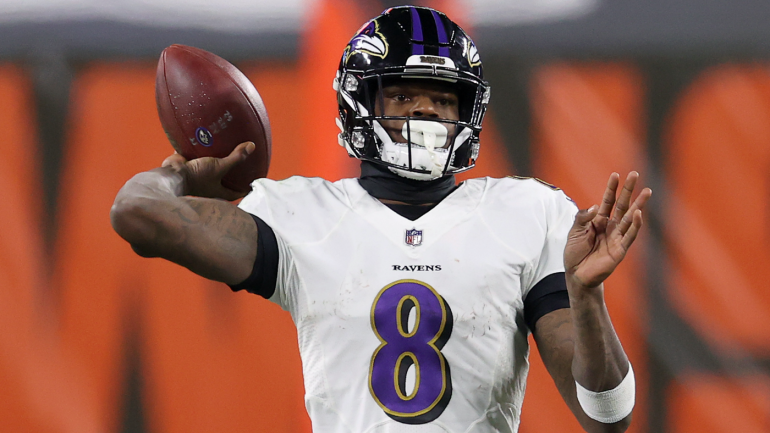
Dak Prescott made NFL history this week by securing $126 million in guaranteed money as part of his $160 million extension with the Dallas Cowboys. The quarterback is now also the second highest-paid player at his position, behind only Kansas City Chiefs superstar Patrick Mahomes. But Dak's big deal likely won't be the last of the 2021 offseason.
While the Cowboys waited a long time to lock up their former fourth-round draft pick, a handful of other teams won't want to drag out inevitable extensions for their own young signal-callers, especially when long-term deals could free up short-term salary cap space at a time when teams are wrestling with pandemic-related cutbacks. We're looking at three QBs, in particular: The Browns' Baker Mayfield, the Bills' Josh Allen, and the Ravens' Lamar Jackson, all of whom have rookie contracts that expire after 2021.
All three QBs could conceivably be kept through 2023 without big-money extensions; each of their respective teams can exercise fifth-year options this offseason, as well as potential franchise tags the following year. But the more cost-effective route tends to mean paying up sooner rather than later. And at this moment, all three QBs from the 2018 draft class are virtual locks to stay put.
With that in mind, who's most likely among Mayfield, Allen and Jackson to get the biggest deal?
First, let's consider their respective impacts after three seasons in the NFL:
- Mayfield, the No. 1 pick in 2018, has easily been the most "pedestrian" of the trio, enduring a big drop-off after a promising rookie year before rebounding in 2020. But he's also, quietly, been arguably the most prolific passer of the bunch over three years. His arm and size aren't nearly as jaw-dropping as those of Allen, but he leads the group in touchdown passes and yards per game. As more of a rugged game manager for Cleveland's run-heavy offense in 2020, Mayfield looked far more comfortable.
- Allen, who went No. 7, has enjoyed the most meteoric rise, going from boom-or-bust play-maker to legitimate MVP candidate. His knack for extending plays will always attach some risk to his game, but he silenced hordes of pre-draft and early-career critics by upping his accuracy late in 2019 and in 2020. A bulldozer on the ground, who leads the trio in rushing scores, he's the surest, most exciting thing the Bills have had under center in decades, and it's arguable his ceiling is the highest of the group.
- Jackson, who lasted until No. 32 in the draft, is the most physically gifted of the group, as his record rushing marks showcase. Kyler Murray is on his way, but there's no QB in the NFL who can move quite like Jackson; his break-neck speed and change of direction can change a game in a heartbeat. He's also got the best starting record of any QB here, by far, though his playoff performances have been much less inspiring. The question with Jackson is whether he can consistently throw his way to victory.
Here's a breakdown of all three QBs' numbers through three seasons:
| QB | Starts | Record (Playoffs) | TDs | INTs | YPG | Comp. % | Rating | Rush Yards (TDs) |
|---|---|---|---|---|---|---|---|---|
Baker Mayfield | 45 | 23-22 (1-1) | 75 | 43 | 241.6 | 61.9 | 89.1 | 437 (4) |
Josh Allen | 43 | 28-15 (2-2) | 67 | 31 | 220.6 | 61.8 | 90.4 | 1,562 (25) |
Lamar Jackson | 37 | 30-7 (1-3) | 68 | 18 | 154.0 | 64.0 | 102.6 | 2,906 (19) |
If one thing should be clear, it's that all three are due -- and will almost assuredly receive -- big-money extensions. But here's how we'd rank their chances of actually resetting the market, which Mahomes set with his $450 million megadeal in 2020:
3. Baker Mayfield (Browns)
Projected deal: Four years, $134 million ($33.5 million per year)
He's the toughest to project simply because his trajectory has been less clear. Do/should the Browns want to keep him? Yes. He proved in 2020 he can adapt to different roles under center, and he brings moxie to point guard-like responsibilities in Kevin Stefanski's offense. But should the Browns buy the possibility he's the next Russell Wilson? We're not so sure, and neither are they, probably. A four-year deal would allow both sides to reassess when Mayfield is just 30. A $33.5M annual average, meanwhile, would put him comfortably as the fifth- or sixth-highest-paid QB, roughly equivalent or ahead of Jared Goff ($33.5M), Aaron Rodgers ($33.5M), Kirk Cousins ($33M) and Carson Wentz ($32M), but just behind more proven QBs like Deshaun Watson ($39M) and Wilson ($35M).
2. Josh Allen (Bills)
Projected deal: Four years, $168 million ($42 million per year)
Prescott's deal surely helped Allen, who will almost certainly command more than $40M per season, considering he's about three years younger and boasts splashier play-making ability, not to mention a recent AFC title-game bid. The fact he's only gotten better each season in the NFL gives his representation plenty of leverage, too; outside of Mahomes and maybe Watson, which other young QB is on a clearer upward trajectory to MVP-level stardom? Buffalo probably won't match Mahomes' annual average considering Allen's still got big-time playoff games to win, but the money should make him a guaranteed top three highest-paid QB.
1. Lamar Jackson (Ravens)
Trying to pick between Allen and Jackson for the next biggest deal is like flipping a coin, and plenty of personnel people would prefer Allen's passing prowess over Jackson's legs. To be clear, Allen could very well top this list in terms of new money, because the reality is he's looked more like the total package during his ascent. But Jackson has a few things working in his favor. For one, he's incredibly young; he just turned 24, meaning even a four-year deal would put him back on the market at 28. His athleticism, we've noted, is also unparalleled, giving the Ravens one of the NFL's one or two best pure, transcendent talents. For all the guff he gets for his first few playoff starts and inconsistent aerial numbers, Jackson is the closest to Mahomes' level in terms of physical gifts, and that'll buy him so much leeway -- most of it justified -- as he continues to develop.
Projected deal: Four years, $170 million ($42.5 million per year)

















